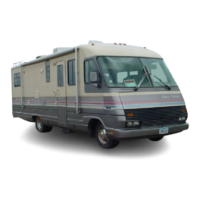113
Discovery, Discovery LXE, Pace Arrow, and
five minutes per hour. If
the breaker trips, it will
automatically reset in
30 minutes to one hour
depending on ambient
temperature.
After Extending the Awning:
After the awning has fully
extended, no further setup or
hardware installation is necessary.
The 120 Volt AC power supply
must remain on for the awning
to automatically retract in excess
wind. The awning is equipped with
a roof-mounted anemometer (wind
speed sensor) to detect wind speed
and automatically retract (requires
120 Volt AC) the awning when wind
speed exceeds a preset speed for
more than a few seconds. If the wind
speed sensor retracts the awning,
leave the awning retracted until wind
subsides to prevent possible awning
damage. While the awning is
equipped with a wind speed sensor,
it is preferred to retract the awning
in inclement weather conditions
or when leaving the motorhome
unattended due to sudden changes in
weather that can occur.
Retracting the Awning:
Clear away any leaves,
pine needles or other debris
by lightly tapping the
awning from underneath
using a broom handle or
other instrument that will
not harm the fabric.
NOTE:
If the fabric is wet when the
awning is retracted, extend
the awning at the earliest
opportunity to allow the
fabric to thoroughly dry.
If the awning does not
operate:
Ensure 120 Volt AC is on
by hooking to shore power,
starting the generator or
turning on the inverter.
Check the circuit breaker
in the load center.
The circuit breaker inside
the awning motor may have
tripped. Wait 30 minutes
to one hour then retry. If
the awning still does not
respond, the awning can
manually retract by using
the supplied telescoping
crank handle.
Wind Sensor:
The patio awning includes a
wind sensor (anemometer) that
will retract the awning in case
of sustained winds. In order for
the wind sensor to operate, the
motorhome must either be hooked
to shore power, have the generator
running or the inverter turned on.
The wind sensor is wired to a
control box that will automatically
retract the patio awning when wind
speeds greater than 18 mph are
detected (at sensor) for 10 seconds.
The control box will override any
command from the remote until
wind speed falls below 18 mph for
one minute.
When the wind sensor attains
the set speed for more than a
few seconds the awning will
automatically retract, provided the
awning has 120 Volt AC power.
The awning will not automatically
open when wind speed subsides,
but must be opened using the
switch or remote.
Awning Care & Cleaning
On a monthly basis, loosen
hardened dirt and remove dust
from the awning with a dry,
medium bristle brush. Thoroughly
rinse both the top and bottom with
a garden hose. A high-quality
fabric cleaner may be used to help
maintain appearance. Carefully
follow the instructions on
cleaning products. Metal surfaces
should be cleaned with soapy
water and thoroughly rinsed.
Allow the awning to thoroughly
air dry while extended. Awning
maintenance products can be
found at RV supply stores.
Girard Awnings:
Mix a solution of mild soap
(natural soaps are best) and
water. Use a brush to apply the
solution. Thoroughly rinse to
remove soap. If a liquid detergent
is used, a water repellant (such
as 303 Hi-Tech Fabric Guard)
treatment will have to be applied.
For stubborn stain removal contact
Girard Systems.
Acrylic Awnings - Wash both
sides of the awning with a mild
soap (i.e. dish soap) and lukewarm
water. Do not use detergents. If
necessary, reapply the solution
to keep fabric saturated. Rinse
the awning thoroughly. Repeat, if
necessary, until most of the stains
disappear. Contact Carefree of
Colorado for removal of stubborn
stains.
Polyweave and Vinyl Awnings
- Mildew will not form on the
awning material itself, but may
form on the dust accumulated on
the canopy. A quality vinyl cleaner,
such as Carefree Awning Magic,
will help keep the awning looking
new. A mild soap (i.e. dish soap)
and lukewarm water solution can
be used. Do not use detergents. Be
sure to follow the instructions on
the container.
030929d
Located on the roof

